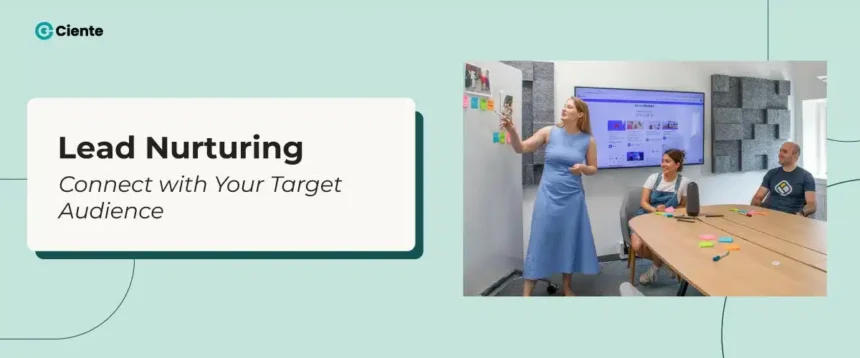Business deals are all about relationships. And developing long-term loyal ones requires spearheaded attention and a lot of patience.
“Lead nurturing is about building authentic connections,” states Salesforce.
A marketer’s pathway to generating leads shouldn’t be hyper-focused on the transactional value. Your clients aren’t just revenue reservoirs. They are the nay-sayers of how your brand is perceived, influencing its reputation and marketing positioning.
It’s a two-way relationship.
While they need your solutions, you need them, too, to improve your standing.
However, the increased marketplace contention has elevated the dilemma for businesses operating within the same industry and target market: Why would they choose us?
The truth is, if the prospective clients don’t deem your brand credible and reputable, they’ll rarely look back. This is far from each business’s actual goal: to convert prospects into active customers.
But modern marketers must do things differently.
Approach the ‘conversion’ process as more than just ‘closing a deal.’ And undertaking a value-centric approach, targeting potential customers at every step of their buying journey.
The only schism here is an innovative understanding of what exactly a “value-centric” approach is. And not just a conventional reading of the benefits you offer.
Marketing has to move beyond promoting the same services and products. This old playbook doesn’t work anymore. Instead, it should be about rethinking and engineering an agile marketing method for buyers.
The reality has reminded marketers that originality comes in waves, but being unique isn’t always about being original. In marketing, it’s about taking what exists and molding it in a way that facilitates your business to prove its value in ways different from traditional ones.
But to deliver this value and prove its worth, businesses must relinquish the presumption that clients are mere buyers.
Even marketing at large omits that customers aren’t just consumers.
In B2B, the decision-makers in a buying committee are also creators and developers, trying their best to navigate familiar business challenges.
So, marketing’s customer-first approach can only take root when it offers an end-to-end partnership. This means working ‘with’ the clients from the beginning till the end to ensure their experiences seamlessly integrate with the marketing solutions.
HBR’s assertion that “people are the new channel” can work as the underlying basis of your customer-first value-driven strategies.
This thinking underscores that your marketing team isn’t just a solution, or the customers aren’t mere numbers – both parties are extensions of each other.
This is what lead nurturing is about.
Lead nurturing means building and communicating value to prospective clients.
To offer you the general purview of how lead nurturing works:
What is lead nurturing?
Fundamentally, this marketing strategy entails offering valuable resources to leads, persuading them to advance further into the sales funnel.
First, marketers focus on capturing or grabbing leads’ interest through compelling and personalized assets. Then, the efforts are directed at deepening the relationship by addressing critical pain points and positioning your brand as the go-to solution.
During this conversation, your brand is centered as a friend and a consultant. You hear the potential buyer’s challenges and offer advice as the subject-matter experts. At the nucleus is the unique value proposition and the tangible value you can offer them.
Through the nurturing process, you’re making a promise: to be their end-to-end partner, not just a one-off deal.
And this is why the tone of communication takes much precedence. There’s much to do even before your brand moves to its sales pitch. Lead nurturing earns you the right to pitch your proposal.
Outlining the lead-nurturing process this way makes it seem demanding. And the truth is, in the modern B2B buying landscape, it is.
Why is nurturing leads vital for conversion in the first place?
The expansion and emergence of B2B businesses have saturated and overwhelmed the client with analysis paralysis. And even when buyers end up making a deal, lackluster solutions and unmet promises have only ensued distrust. It has led to a generic hesitance when leads first enter the sales funnel.
They cannot progress down the funnel on their own. But a little guidance can help them. In this case, lead nurturing functions as a guide to those who already illustrate purchasing intent.
But, for curious onlookers, the nurturing process might be an informative session for getting to know the brand. It all boils down to active and ongoing communication across all active channels.
And, most crucially, making an impression.
It’s imperative to your brand’s success. Not everyone who enters your funnel holds purchasing intent or purchases right away. With B2B buying going digital, it’s likely the buyer found you through an online search. And even though most buyers have become self-directed and make decisions even before talking to an SDR, they need convincing to move in the right direction.
So, once the lead’s been captured, it’s time to cultivate it.
It’s likely that the lead is researching alternate options at this stage. And any small active interaction with your brand is a win. Every touchpoint gives you the opportunity to nurture that lead, and that’s how it should be.
Once the lead has entered the funnel, they shouldn’t feel ghosted, or else they get easily siphoned off by your competitors.
Lead nurturing illustrates how valuable a customer’s time is to you and that you’re with them at every step of the funnel.
The customer should believe in your brand’s capability to cater to them. Ideally, the lead-nurturing process should assure the buyer that you won’t waste their time.
If you look at the bigger picture, lead nurture is paramount to:
- Educate your buyers
- Elevate brand recognition and recall
- Develop an external relationship with your brand
- Improve conversion rates
Now that we have outlined why lead nurturing is a requisite for each business, we move on to its working model. The process sounds easy in theory, but the practical execution is where marketers miss their mark.
To navigate this, marketers must focus on the basic structure and strategic approach.
But before diving into the strategy, let’s get into the generic framework. What does the lead-nurturing process look like?
Lead nurturing process: the basic structure.
Primarily, there are the underlying factors required to kickstart your lead-nurturing efforts:
1. Segmentation
Personalization has become the heart of marketing communications. From AI to automation tools, every resource is used to curate targeted campaigns and messages.
To ascertain whether these efforts are successful, start by segmenting your customer list. It will straighten the tailoring and customization of your communication strategies. While not all customers resonate with the same idea and message, some do.
Segmentation will ensure that your marketing team isn’t blasting the same email to each potential customer. The segments with similar pain points and interests will obviously resonate with the same type of messages.
This will assist you in streamlining the marketing efforts and creating content that actually engages the audience.
2. The right content
Your ICP is diverse. And even the decision-makers within a single buying committee have distinct tastes. Not all can resonate with the same piece of content.
The first ingredient is targeted content. Find out where your leads are in their buying journey and curate content that aligns with the buyer persona. This is crucial and includes the multiple touchpoints each customer interacts with.
Imagine firing off messages that are known to every business in the vicinity. Most brands do this by taking a single generic message and reshaping it to sound different.
Certainly, you don’t wish to be one of them.
Underscore what works best for your brand, personalize, and experiment because what works for you might not work for your customer. And to make it easier to reach them, expand it through diverse marketing channels.
From podcasts to SMS, cover all bases to find the line that works for you. Uncover the cadence and frequency of messages to ascertain you don’t overwhelm the potential buyers.
And most of all, find the resonating sweet spot that intrigues your audience.
3. Unique buyer persona
How well do you know your ideal buyer? – A question that entails the building block of each marketing campaign.
Knowing what your best customer looks like is fundamental to creating these campaigns from the tiniest nub.
- Demographic details
- Common pain points
- Interests
- Preferred communication channels
- Underlying motivations
Identifying your buyer and creating a persona will help you optimize your strategy and build the process around it. Simply, you can ensure your nurturing efforts are more tailored and customized.
4. The journey
From a broader perspective, B2B sales cycles are lengthy, complex, and time-consuming. However, as a marketer hoping to improve the hand-off with sales and influence conversion, you need to narrow down your understanding.
Outline how long your business’s sales cycle is: What is the typical timeframe for a lead to move from the initial contact to the deal closing?
Every single touchpoint adds to this. Understanding the sales cycle length can help gauge when the customers actually get ready to buy, along with a brownie point: how your customers move through.
This helps study the buyer and their patterns better.
Lead nurturing remains the same across businesses. However, some details in your customer journey might influence the particularities.
5. Brand building
Your customers don’t want to communicate with or buy from an organization. They want to interact with a person. Rather than communicating with a concrete corporate entity, they want to gauge the brand’s personality.
That’s what makes the first impression – the personal brand.
This is why it’s so crucial for your business to have this front – a story and a narrative. Storytelling is vital in sales, and a story with intent can work wonders. This begins with positioning your business as a credible thought leader in the market.
But it’s crucial to showcase your knowledge and expertise to build this credibility. If your brand’s broader market perspective is positive, it’s easier for potential customers to catch up.
Here, lead nurturing becomes simple.
So, when creativity is a constant at the nucleus of the road mapping process, don’t think of it only blooming in ad campaigns or personalized messages. It should rather be a driving force, encouraging creation and reiteration in your buyer’s imagination.
Beyond these underlying factors embedded at the crux of every nurturing process, there’s a framework to it. You amalgamate all these aspects into a mix and then hope for the best.
Lead nurturing doesn’t work this way.
It’s about supporting your customers through their business challenges and delighting them. The lead-nurturing campaigns should ‘wow’ potential buyers and excite them to get in touch with you.
Without the slightest intrigue, the prospect fails to see the unique value in your solutions, becoming one with the cacophony of market noise.
So, what are some of the lead-nurturing best practices?
While progressing through the funnel, we understand that leads are at different stages of the purchasing journey – some have made up their minds, and some are still hesitant.
This is where lead nurturing grows into different branches, each for a different stage in the funnel:
1. In the awareness stage (Top of the funnel), the lead is cold, cautious, and hesitant. So, the initial contact should offer them value that urges them to take action.
What can you do? – send emails and newsletters, publish blogs on relevant topics that address their pain points, and run targeted ads.
2. The next stage is interest (middle of the funnel), where the lead has undertaken substantial steps to understand who you are and what you offer. Most often, this turns out to be curiosity rather than actual purchasing intent. But now that the lead is captured, intent can be built.
What can you do? – Guide them towards downloading more services-specific content, such as e-Guides and whitepapers, or initiate a discovery call to gauge their pain points.
3. The consideration stage is paramount. At this stage, the lead compares your solutions with the competitors’ – pricing models, tangible benefits, agility, and integration capabilities.
Once potential customers become aware of the brand’s services and agree with you, your brand becomes one of the many. So, now walk them through the nitty-gritty (features) and dive further into how they’ll solve their pain points and help drive results.
What can you do? – Offer detailed content such as demos, pricing sheets, a customized sales presentation, and relevant case studies.
4. Interacting with a lead in the evaluation stage signifies that they hold serious buying intent. For this, you get into the USP – brand differentiators. To further establish this, offer a sales proposal highlighting personalized solutions relevant to their business requirements and pain points.
But it doesn’t end with closing the deal. Follow-ups are necessary, even with existing customers. Closing a purchase with a first-time buyer doesn’t automatically mean trust or loyalty. It’s the second purchase from the same buyer that actually holds prominence.
It means they trust you. And this is what lead nurturing promises to achieve.
These techniques directly impact a customer’s decision to purchase or not. This is why nurturing holds such an imperative space in the funnel. But without the right strategy, marketers lose their way to convert even the most active leads.
An efficient nurturing approach requires a synergy between innovative marketing and sales strategies. It has to be smart and move beyond the generic.
But reaching this mountain top requires taking the first step. This means underscoring some of the best lead-nurturing strategies.
The lead-nurturing strategies to earn customer loyalty.
1. Leverage multiple channels in your campaign.
In the highly digital landscape, customers can be reached through more than a single channel, whether it’s through ads, social media, or emails – each of them is paramount. The more channels, the easier it is to interact with potential buyers.
Digital transformation has made customer communication straightforward. While many nuances are involved, modern lead nurturing has to transcend generic email drip campaigns. It’s just one of the many in this digital age.
Generic emails don’t do it anymore.
It gets lost amidst the same recycled messages with no value or impact. But now, marketing automation tools can help you set up multichannel campaigns.
An effective and robust nurturing campaign includes retargeting ads, social media, email marketing, sales outreach, and tailored website content. And a framework that allows these to perform effectively and cohesively.
2. Conduct periodic and timely follow-ups.
Most businesses let the interaction soak in, but sometimes, this results in a significant gap between communications. This error can cost them a customer, but most SDRs still fail to acknowledge this.
Automated lead nurturing focuses on the quantity, but periodic follow-ups demonstrate that you care about them. They are still as valuable to you as they were beforehand. Because, as HubSpot asserts,
“The odds of converting a lead into a sales opportunity are exponentially higher when the lead is contacted immediately following a website conversion.”
Your team already has information regarding the prospect – you know what they are researching and their intent. This can help lead a really informative and in-depth call that isn’t as disconnected as cold calling.
You know the prospect’s current behavior, and a timely follow-up is one of the best ways to convert inbound leads.
3. Leverage aligned lead-scoring tactics.
Lead scoring is one of the best pathways to optimize your lead-nurturing strategies. Once aligned with the brand guidelines, the only thing left is utilizing these scores to focus on what actually matters.
Lead nurturing takes ample time – sometimes, it works, and then, it doesn’t. So, marketing and sales cannot just spend most of their time nurturing a cold lead. Here, lead scores play an integral role.
It helps segregate how much time and resources should be spent on each lead and which are relevant and must be prioritized. Not only will leveraging lead-scoring techniques simultaneously help you prioritize hot leads, but highlight the channels that work best for your nurturing processes.
4. Personalize the process.
A customer’s behavior illustrates their needs, interests, and preferences. And this matters to marketers, too. And truthfully, if the communications are tailored according to these, the engagement and conversion rates are higher.
It makes the customers feel heard and understood.
So, savvy marketers are meeting their digital buyers halfway. They use data and analytics to curate personalized and compelling strategies that hit the mark. It could include anything from customized email content based on past purchases and recommendations to the frequency of communications.
There’s another facet – dynamic content that targets buyers based on their position in the funnel, industry, or job. All of this boils down to a single aspect – experiences that feel unique to the situation and need.
The bottom line is that the customer needs to feel valued.
Marketing’s solution was to establish a relationship-driven, nurturing technique, not a transactional one. At the heart of this is engagement and communication.
There are innovative ways to carry this out, but not entirely original ones. What’s impactful is how your marketing creativity approaches lead nurturing without straying from the brand vision and motto.
Building a lasting relationship, loyalty, and trust isn’t built in the blink of an eye. It requires patience, and with the nurturing process, this is what takes the front seat – to see what works and what doesn’t.
There’s no hard and fast rule for any marketing strategy, just experimentation. The only play here is to recognize the core: customers and value.
In an intensely competitive marketplace, buyers also need assurance that their demands and challenges are pinpointed. Nurturing remains a sure-shot way to highlight less intrusive methods for showcasing that your buyers matter to you.

















